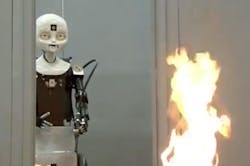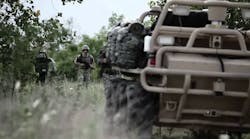Ballam: Robots in The Fire Service? Say it Ain't So.
Robots fighting fire? Preposterous, you might say. But wait a minute, the future is here and autonomous fighting machines are making their way into the fire service in a big way.
As far-fetched and “Star Wars” like as it might sound, there will be a day when our colleagues will have nerves of steel, literally.
I was at the International Fire Chiefs Association Fire Rescue International show in Chicago recently and one of the myriad of things that immediately caught my eyes was a red six-wheel amphibious looking rig that I had never seen before. Trust me. I’ve been to a lot of trade shows over the years and it takes quite a lot for me to stop in my tracks.
The gizmo at FRI isn’t the only robotic thing the fire service is trying out. The Navy is working on a Shipboard Autonomous Firefighting Robot (SAFFiR) unit that looks like a human. And Purdue University successfully deployed a tracked firefighting robot at a used tire processing building fire in Hoopeston, Ill., earlier this year. But more about those later.
I circled the beast at the McCormack Convention Center in Chicago looking for its operator’s seat and controls. I couldn’t find any. There must be a problem. I walked around again and found a 9,000-pound winch on the front, and a remote-controlled turret monitor on what resembled a front bumper. There were red warning lights on the vehicle, that’s about the size of a Volkswagen Beetle, a chainsaw, some hose, a skid unit with a pump and tank, a patient litter, some forestry tools.
Nope. No place for the operator.
The vendor from Lockheed Martin noticed my puzzled mug. I couldn’t help myself. “Where’s the operator’s controls,” I asked.
“There isn’t any,” the pleasant young man responded with a knowing smile “It’s autonomous.”
What? The maker’s representative then said there was a manual override stick deep in the belly of the beast just in case.
It’s mission, however, is to follow firefighters into battle, lugging stuff that’s either too heavy or to give personnel a break from backpack and equipment toting. It can be programmed to literally follow a person through just about anything and anywhere, or it can be programmed to go to a set of coordinates all by itself, hence the autonomous part of the vehicle’s features.
The vehicle is so new it literally did not exist a week before the FRI show. The firefighting vehicle is based on Lockheed Martin’s Squad Mission Support System unmanned ground vehicle designed for the military in Afghanistan deployments. According to the maker, four SMSS vehicles were sent to Afghanistan for a five-month in-theater assessment where they were used for combat outpost and strong point resupply, demolition material transport, communications equipment transport, portable power and battery charging and transport of infrastructure material like fencing equipment and tools.
So, what does that have to do with firefighting you might say? Good question.
There’s speculation that as military spending dries up, government vendors are looking for new customers and part of their business model is providing equipment to the fire service. Hence, Lockheed Martin’s modified SMSS showing up on the show floor of IAFC’s FRI show.
At the show, company representatives say the new-modified SMSS can provide similar services to firefighters as it does in the field with soldiers and go where it’s not safe to send personnel.
Granted, the unit is a rudimentary robot, but anytime a machine can do something by itself using hi-tech electronic wizardry, it’s pretty cool.
The red machine at the show, powered by a Kubota diesel engine, carried firefighting water in a tank, had a pump and a reel with hose and nozzle, plus at least one extinguisher and enough hand tools to supply a wildland firefighting crew, plus a few other accessories that appear to be completely customizable for whatever needs the agency might require.
The 4,300-pound vehicle has a 125-mile range, can be programmed to follow a person or another vehicle, operated with voice controls, tethered or remote controlled with a line of sight and can even be controlled via satellite by remote operating stations.
While it’s anyone’s guess whether the fire service will embrace the technology, it’s not the first entry into the robotic firefighting market.
As I mentioned earlier, the Navy is working on a firefighting robot and trying to develop human-centric autonomous system for fire safety and damage control. The initiative is part of the Innovative Naval Prototype program – Damage Control Technologies for the 21st Century (DC-21).
The objective of the shipboard autonomous firefighting robot (SAFFiR) is to develop human-centric, autonomous systems for fire safety and damage control. This will reduce ship’s vulnerability to damage and decrease the recovery time while significantly reducing life cycle costs, size and weight of future damage control systems.
This technology will allow the Navy to meet damage recovery mandates and reduce human risks. The SAFFiR is a key component of a candidate Innovative Naval Prototype program – Damage Control Technologies for the 21st Century (DC-21).
While some have called the Navy’s robot creepy (it has a face that looks a little like Casper the ghost) it is designed to interpret human gesturing and natural dialog, interacting with real firefighters as a member of a team.
Sensors allow the robot to have situational awareness and the ability to detect gases and incipient fires.
When they’re deployed in the field for real, no estimate on when, they’ll be able to navigate ships easily with 3-D maps programmed into their systems, use thermal shielding equipment and manipulate fire suppressors, like nozzles and hoses.
Ships are reportedly very dangerous environments in which to fight fire and we can pretty easily figure out why. If I could send a robot into that environment rather than a human firefighter, I would do that all day long.
Closer to reality was the successful deployment of a Korean-made robotic firefighting tank-like vehicle at 400,000 square foot factory fire in Hoopeston, Ill., in June.
The 400-pound, two-foot tall steel firefighting machine dragged a charged 2-inch hose deep into a collapsed building and put out hot spots that neither humans firefighters, nor those on aerials could reach.
Students and faculty were helping the company perfect the device and it was the first “real-world” deployment of the device. It proved very promising. It was originally designed to deliver water in places just like the used tire processing facility, but Purdue faculty and students think it has much more potential. With a few more sensors, it could test for gases in inaccessible areas, and for floor integrity in fires or collapsed structures.
Humankind has the capacity to engineer and imagine its way out of any situation. Ingenuity is usually only limited by need and finances.
I have long been skeptical of robots in the fire service, but I think we’re on the verge of a breakthrough that could revolutionize the way we fight, and prevent, fires. There are a lot of really smart people working on it in universities and industrial setting nationwide. I believe they're doing it to keep firefighters safe.
When innovation, creativity and need match up with financial feasibility, I predict we’ll see some dramatic changes in firefighting techniques.
After all, we are in the 21st century and isn’t that when all the science fiction stuff is supposed to become reality.
Stay tuned.







